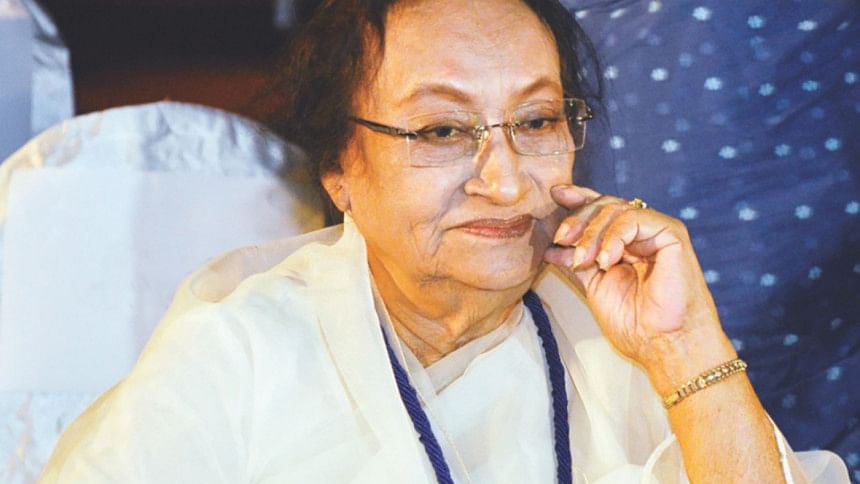The legacy of a legend

It was May 1990. World renowned singer Feroza Begum was on a three-month tour of the United States as part of the first Nazrul Conference in North America. I had the rare privilege of accompanying her on the tour and observing a legendary personality from up close.
Feroza Begum was uncompromising in her art. Whether it be the song selection, the choice of musicians accompanying her on stage or picking out a necklace that would inevitably form part of her ensemble, her decisiveness was well-known. Without fail, she would appear on stage in an elegant saree and immerse the packed audience in a spellbinding performance. She would often start with a Nazrul raga-based song and then drift to several genres of melodies and Urdu geet-ghazals treating the listeners to the breadth and depth of her genius. A standing rapturous ovation once when she alighted the stage or when the final curtains reluctantly fell, became the norm.
On a trip from New Jersey to New York we were caught in traffic. To while the hours away, she started to recount memories of how a young girl grew into a virtuoso artiste.
"Singing came as naturally to me as breathing. To start with, I had no tutor; I simply tried to pick up tunes from the gramophone records strewn all over our storeroom. I had little knowledge about the musical nuances. Fortunately, at that time I came across stalwarts such as Chitta Roy (personal assistant of Kazi Nazrul Islam) and later the incomparable composer Kamol Das Gupta."
"As I trained under Chitta Babu for almost two years I was fascinated by the exquisite compositions Chirotorey durey choley jabo, Tumi shundor tai, Tumi shunitey cheyo na, Ekadoshir chand and other songs by Kazi Nazrul Islam."
The year 1960 marked a turning point in her life. The Gramophone Company of India approached Feroza Begum to record songs for Puja. The Kamol-Feroza pair exploded into the genre of adhunik songs. She revived the popularity of Nazrul songs and recorded Momero putul and Duur dwipobashini. Her unparalleled style added a new dimension to the genre and sold out three months in advance. Musafir mochh rey ankhi jol, her second recorded song, took her popularity to new heights.
In those days it was difficult to progress without singing for playbacks, which she flatly refused. Such was her popularity, that she continued to rise in fame despite turning her back on playback songs.
In 1979, she recorded 3 LP's of adhunik and Nazrul songs, which were record hits as well. Astounding though it may sound, she performed a record 380 solo concerts.
It was under composer and husband Kamol Das Gupta that she blossomed in semi classical music. Kamol Dasgupta was training under legendary Ustad Zamiruddin Khan—as was none other than the genius Kazi Nazrul Islam. Belonging to the same gharana, Kamol Das and Nazrul Islam, had a similar mindset, and the music they composed together seemed to find its natural voice in Feroza Begum.
As prolific as she was, she had a natural eye for every detail. When I was preparing for a performance at the MIT University hall, she would tip-toe into my room and suggest some new beautiful touches to the song Porodeshi bodhu…ghuum bhangayo chumi aankhi. At other times when my husband and I were out at dinner with her, she would pick up on a passing remark and recount interesting anecdotes from her life. Even later, when I recorded my CD "Elo Phuler Morshum" for HMV under her direction, she would listen intently to every note in the master track before signalling her final approval.
I shall always treasure those days when we had the opportunity to work closely with her on different TV programmes that she directed or the first Nazrul Sangeet Sangstha that she formed to bring the country's Nazrul artists under one umbrella. The Nazrul Sangeet singers would have benefited greatly had the platform continued for some time longer.
A year has passed since the songbird left behind her music lovers. The silent masses that had gathered on the steps of Shaheed Minar to pay their last respect was a testament to the love she had nurtured not only with listeners but also with an art that she had helped shape for over fifty years.
With head bowed they listened one last time as she took centre-stage and her song played on the airwaves—"Ami chirotorey durey choley jabo, tobu amare dibo na bhuliteye" ("I will leave you forever, but shall not let you forget me for once").
Her lips did not move as her song played but for the sea of admirers who silently whispered the lyrics, this promise was already sealed with love.
Sadya Afreen Mallick is a renowned Nazrul Sangeet exponent and Chief, Culture Initiative, The Daily Star.
This article was first published on September 9, 2015. Today (August 4) Dhaka University will be holding the Feroza Begum Gold Medal Award Ceremony.

 For all latest news, follow The Daily Star's Google News channel.
For all latest news, follow The Daily Star's Google News channel. 



Comments